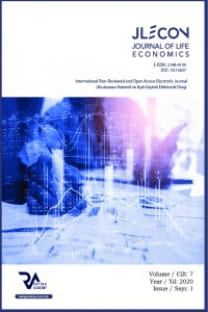PARA VE MALİYE POLİTİKALARININ SAĞLIK SEKTÖRÜ ÜZERİNDEKİ ETKİSİ VE TÜRKİYE İNCELEMESİ
Çalışmanın amacı, iktisat politikasının alt ana politikaları olan para ve maliye politikalarının sağlık sektörü üzerindeki etkisini Türkiye örneği üzerinden ortaya koyabilmektir. Çalışmada para ve maliye politikasının sağlık sektörü üzerindeki etkisini incelemek amacıyla para politikası ve maliye politikası etkisinin tespit için iki ayrı model kullanılmıştır. Kurulan modeller aracılığıyla öncelikle eşbütünleşme analizi yapılmış daha sonra VAR modeli aracılığıyla, değişkenler arasındaki ilişkiler hata düzeltme modeli (VECM) ve Etki-Tepki analizi uygulanmıştır. Araştırma sonucunda para politikalarına kıyasla maliye politikalarının sağlık sektörü üzerinde daha etkili ve duyarlı politikalar olduğu görülmüştür.
Anahtar Kelimeler:
İktisat Politikası, Para Politikası, Maliye Politikaları, Kalkınma Sağlık Harcamaları, Sosyal Sağlık
MONETARY AND FISCAL POLICIES EFFECT ON HEALTH SECTOR AND TURKEY REVIEW
In this study, the effects of monetary and fiscal policies on the health sector aims to examine the example of Turkey. As a result of the study, it is seen that the fiscal policy is more effective than the monetary policy because the coefficients of the variables in which the fiscal policy is represented are larger than the coefficients of the variables in which the monetary policy is represented . In the study, two different models were used to determine the effects of monetary and fiscal policy in order to examine the effects of monetary and fiscal policy on the health sector. Firstly, cointegration analysis was done through the established models, and then, the VAR model, the relationships between variables, error correction model (VECM) and Impact-Response analysis were applied. As a result of the research, it was seen that fiscal policies are more effective and sensitive policies on the health sector compared to monetary policies.
Keywords:
Economics Policy, Monetary Policy, Development, Health Spending, Social Health,
___
- BALTUSSEN, R. ‘’Methods for Generalized Cost-effectiveness Analysis” in T. T Edejer vd. (ed)Making Choices in Health: WHO Guide to Cost- effectiveness Analysis, Geneva, WHO, 2003, 3-97
- BLANCHARD, O., DELL’ARICCIA, G., and MAURO, P. Rethinking Macroeconomic Policy. Journal Of Money, Credit And Banking, 42(1), 2010, 199-215.
- CANDELON, B., MUYSKEN, J., and VERMEULEN, R., Fiscal Policy And Monetary Integration İn Europe: An Update. Oxford Economic Papers, 2009.
- ENDERS, W., Applied Econometric Time Series, New York: lowa State University, 1995
- FISHBACK, P. V, The New Deal. The New Palgrave Dictionary Of Economics, Basingstoke: Palgrave Macmillan, 2008.
- GALI, J., and MONACELLI, T., Optimal Monetary And Fiscal Policy İn A Currency Union. Journal Of International Economics, 76(1), 2008, 116-132.
- HURLEY, J., “An Overview of the Normative Economics of the Health Sector”, in Culter, A. J. and J. P. Newhouse (ed.) Handbook of Health Economics, Amsterdam, Elsevier, 2000, 55-110
- JAWAID, S. T., ARİF, I., and NAEEMULLAH, S. M. Comparative Analysis Of Monetary And Fiscal Policy: A Case Study Of Pakistan. 2010, 58-67
- KIRILMAZ, H., Sağlık Sisteminin Sorunları Ve Bilgi Teknolojileri, 2. Ulusal Tıp Bilişimi Kongresi/Medical Informatics 05 Turkey Bildiriler Kitabı, 17-20 Kasım 2005- Antalya, 2005, 90-92.
- KOHLWES, S., Governing Health, Transformations İn The Turkish Health Care System, Get Ma Working Paper No. 8. Department Of Social Sciences, Humboldt-Universität Zu Berlin, 2014.
- MİSHKİN, F., HEBEL SCHMIDT, K., “Monetary policy under inflation targeting: an Introduction” Economia Chilena 9, (3) :5-17
- MOUNTHFORD, A. HARALD, U., “What are the Effects of Fiscal Policy Shocks?”, NBER Working Paper Series, 2008, No:14551.
- OBSTFELD, M., SHAMBAUGH, J. C., TAYLOR, A. M. The Trilemma In History: Tradeoffs Among Exchange Rates, Monetary Policies, And Capital Mobility. Review Of Economics And Statistics, 87(3), 2005, 423-438.
- ONARAN, Z., Sağlığın Makrosu (Gazete haberleriyle) Der Yayınevi, İstanbul,2020
- ÖZGEN, F. B. ve GÜLOĞLU, B. “Türkiye’de İç Borçların İktisadi Etkilerinin VAR Tekniğiyle Analizi”, ODTÜ Gelişme Dergisi, Haziran 2004, Sayı: 31, 2004, 93-114
- TARIK, R. Ekonometri. Umuttepe Yayınları, Kocaeli, 2010.
- YEĞİNBOY, E. Y., SAYIN, K. Ş., Cumhuriyet Döneminden Günümüze Sağlık Politikaları Ve Sorunları, 2. Ulusal İktisat Kongresi, 20-22 Şubat 2008, İzmir
- YILDIRIM, E., ÇAKMAKLI, S., ve ÖZKAN, F. Ö. Eskiden Yeniye Neo-Klasik Sentez: Bir Literatür Taraması. Ankara Üniversitesi Sbf Dergisi, 66(04), 2011, 153-184
- DARVAS, Z., MOES, N., Myachenkova Yana and Pichler David(2018) “The Macroeconomic İmplications Of Healthcare” http://aei.pitt.edu/94359/1/PC-11_2018_cover.pdf
- FREDERIC, S. M., (2001) Monetary Policy NBER RESEARCH SUMMARY https://www0.gsb.columbia.edu/faculty/fmishkin/PDFpapers/01NBERRE.pdf
- FREDERIC, S. M., (2001) Monetary Policy NBER RESEARCH SUMMARY https://www0.gsb.columbia.edu/faculty/fmishkin/PDFpapers/01NBERRE.pdf
- SCHAKEL, C. H., WU, H. E., JEURISSEN, P., (2018) “Fiscal rules, powerful levers for controlling the health budget? Evidence from 32 OECD countries” BMC Public Health volume 18,
- https://world101.cfr.org/global-era-issues/monetary-policy-and-currencies/what-monetary-policy
- https://www.rba.gov.au/education/resources/explainers/what-is-monetary-policy.html
- TAYLOR, J. B., (1999) “A Historical Analysis of Monetary Policy Rules” The National Bureau of Economic Research https://www.nber.org/system/files/chapters/c7419/c7419.pdf
- https://world101.cfr.org/global-era-issues/monetary-policy-and-currencies/what-monetary-policy
- YAGIHASHI, T., DU, J., “Health care inflation and its implications for monetary policy” https://www.researchgate.net/publication/273474559_Health_care_inflation_and_its_implications_for_monetary_policy
- Yayın Aralığı: Yılda 4 Sayı
- Başlangıç: 2014
- Yayıncı: Rating Academy
Sayıdaki Diğer Makaleler
PARA VE MALİYE POLİTİKALARININ SAĞLIK SEKTÖRÜ ÜZERİNDEKİ ETKİSİ VE TÜRKİYE İNCELEMESİ
Zahide ONARAN, Esra BAL YILDIZ
Kubilay ERİŞLİK, Özlem DENİZ BAŞAR
OECD ÜLKELERİNDE BİLGİ VE İLETİŞİM TEKNOLOJİLERİNİN İŞGÜCÜ VERİMLİLİĞİ ÜZERİNE ETKİSİ1*
Yagmur AKARSU, Serdar KURT, Nur DİLBAZ ALACAHAN
ASSESSMENT OF THE POSSIBILITY OF A MIDDLE-INCOME TRAP IN TURKEY
